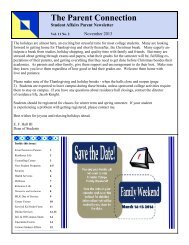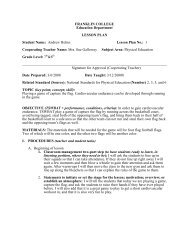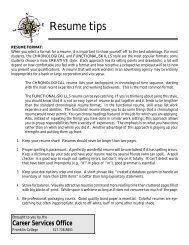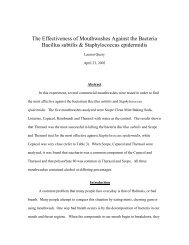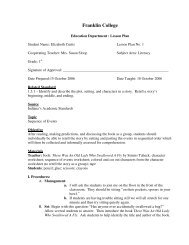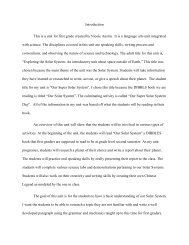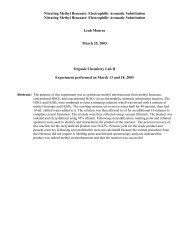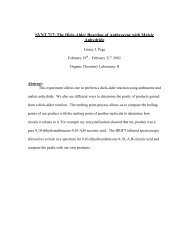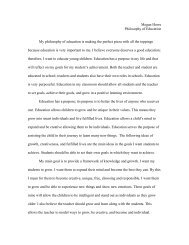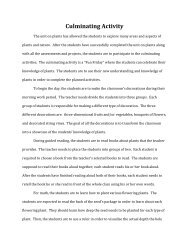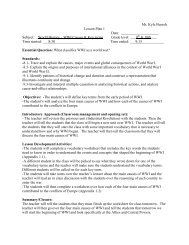Unit Keypoints - Franklin College
Unit Keypoints - Franklin College
Unit Keypoints - Franklin College
Create successful ePaper yourself
Turn your PDF publications into a flip-book with our unique Google optimized e-Paper software.
Seasonal Weather<br />
1. Tracking local weather<br />
<strong>Unit</strong> Key Points<br />
Second Grade<br />
Local weather plays a big role in people’s everyday lives. By tracking<br />
local weather, one is better able to predict what weather pattern may be<br />
approaching.<br />
1.a. Predict the weather daily<br />
The weather changes on a day-to-day basis in most parts<br />
of the world. In order to better predict the weather on a daily basis, one<br />
must watch the different weather patterns that occur over a length of<br />
time.<br />
1.2 What seasons bring<br />
The year is divided up into four different seasons. As the Earth<br />
orbits the sun, different parts of the Earth surface receive different<br />
amounts of the sun’s energy; creating the four seasons. With every<br />
season comes a change in the weather or climate. There is also a<br />
change in nature, such as plants and animals.<br />
1.2.a. The different types of seasonal weather<br />
With every season comes a different type of climate and change in<br />
nature. Summer, fall, winter, and spring all have different characteristics<br />
that make them unique. These different seasons make it possible for<br />
animal and plant life to continue.<br />
1.3 Weather patterns<br />
Weather has many different types of shapes and forms. Looking at the<br />
different seasons one can determine weather patterns. Many people<br />
accept certain weather patterns with each season.<br />
1.3.a. Weather patterns associated with different parts of the country:<br />
The weather in different parts of the country changes drastically. One<br />
part of the country may often have tornados, while the other part of the
country suffers from hurricanes. The weather changes due to the different<br />
positions the states are in compared to the equator.<br />
Air and Wind<br />
1. What is wind<br />
Wind is air in natural motion, moving horizontally at any velocity<br />
along the earth’s surface. Wind is able to transport small materials, such<br />
as seeds, for long distances.<br />
2.a. The affect that heat has on air<br />
When air gets warmer, it expands. This causes warm air to get<br />
thinner and it float upward. Cold air does the opposite of warm air.<br />
2.1.Wind observation<br />
The wind affects the climate and the air pressure. Many<br />
elements in the environment cause changes in the wind.<br />
2.1.a. Learn about anemometers<br />
An anemometer is an instrument used to measure wind<br />
speed. The anemometer is spun by the wind and the amount of spins per<br />
minute are counted and multiplied to get the wind speed.<br />
2.1.b. Why certain areas of the country are windier than others<br />
Where a certain state or country is located plays a big part in how<br />
windy that area will be. Many states located near water tend to have more<br />
wind since there is a warm and cold air exchange happening.<br />
2.2. Wind direction<br />
The air in our atmosphere moves in many directions at varying<br />
speeds. Air is a fluid that moves in a path. Warmer air rises while<br />
cooler air sinks which creates the environment for flowing air<br />
movement. Air moves from an area of high pressure (cold) to an area<br />
of low pressure (warm).<br />
2.2.a. Learn about weather vanes<br />
Weather vanes are instruments used to determine what
Storms<br />
direction the wind is blowing from. The weather vane has an arrow<br />
attached to it, which points in the wind, telling what direction it is coming<br />
from.<br />
2. Thunder and Lightning<br />
Lightning is a brilliant electric spark discharged in the atmosphere,<br />
occurring within a thundercloud, between clouds, or between a cloud and<br />
the ground. Thunder is a loud explosive noise created by an expansion of<br />
air heated by a lightning discharge.<br />
3.a. How thunder and lightning are formed:<br />
Lightning is created when a separation of the positive and negative<br />
charges within a cloud becomes so great that the insulating power of<br />
air is exceeded and great amounts of electricity are then released.<br />
Thunder is formed when warm air and cold air collide.<br />
3.1. Tornados:<br />
Is a violently rotating column of air in contact with the ground and a<br />
pendent from a cumulonimbus cloud.<br />
3.1.a. How does a tornado form?<br />
Tornadoes are often formed by giant thunderstorms known as<br />
“supercells”. When warm, moist air along the ground rushes upward,<br />
and meets cooler, drier air this causes for a massive thundercloud to<br />
form.<br />
3.1.b. Tornado alerts and safety<br />
Flying debris is one of the biggest hazards when it comes to<br />
tornadoes. In order to remain safe there are many precautions that need<br />
to be taken. Shelter needs to be taken when a tornado siren is first<br />
sounded. The best place to take shelter is in a basement or a room that<br />
has no windows.
3.1. Stormy Weather<br />
There are many different types of storms that are associated with<br />
stormy weather. Such storms include tornadoes, hurricanes, blizzards,<br />
and many others.<br />
3.2.a. Different types of weather storms<br />
There are many different types of weather storms. There are<br />
blizzards, a storm that deals with high levels of snow. There are also<br />
storms that occur on the water, such as hurricanes. Tornadoes are a type<br />
of storm that occurs due to hot and humid climate.<br />
3.2.a.1 Parts of the country where these storms occur<br />
Many of these storms occur in different parts of the country due to<br />
climate. Weather plays a big role in producing these storms. In hot and<br />
climates, tornadoes are most likely to occur. In areas that are close to the<br />
ocean, hurricanes often occur over the water and there effects are felt on<br />
the land.<br />
Precipitation<br />
4. Rainfall<br />
It rains when warm, moist air cools down. Condensation then occurs<br />
and droplets form which fall as rain.<br />
4.a. Measuring rainfall<br />
Rainfall is measured in terms of inches or millimeters in depth.<br />
There are many stations all over the world that keep track of the daily,<br />
monthly, or yearly rainfall. A simple gauge apparatus can be used to<br />
measure the rainfall.
4.b. How is rain made<br />
4.1.Puddles<br />
Clouds contain huge numbers of tiny droplets of moisture.<br />
Raindrops are formed when these tiny droplets are enlarged.<br />
Puddles are small pools of water left standing on the ground.<br />
4.2. Different types of precipitation<br />
4.2.a. Sleet<br />
There are many different types of precipitation. Such forms of<br />
precipitation are sleet, hail, and freezing rain.<br />
Rain drops that freeze into ice pellets before reaching the ground.<br />
Sleet usually bounces when it hitting a surface and does not stick to<br />
objects. Sleet can accumulate like snow and be hazardous.<br />
4.2.b. Freezing rain<br />
Clouds<br />
Rain that falls onto a surface with a temperature below freezing.<br />
This causes it to freeze to surfaces, such as tress, cars and roads, forming<br />
a coating or glaze of ice.<br />
5. Different types of clouds<br />
There are four different types of clouds, cirrus, nimbus, cumulus, and<br />
stratus. Each type of cloud has a different characteristic.<br />
5.1 How a cloud is formed<br />
Clouds are formed when air containing water vapor is cooled below a<br />
temperature called the dew point. The result is moisture condenses into<br />
droplets on microscopic dust particles in the atmosphere to create clouds.<br />
5.2. Cloud classification<br />
There are many different types of clouds. Each cloud has a unique<br />
characteristic about it. Along with the cirrus, nimbus, cumulus, and stratus<br />
clouds there are still may others types to explore, such as fog.
5.3. Predicting weather based on cloud coverage<br />
Weather can be predicted by looking at the clouds in the sky, different<br />
types of clouds bring different weather. Cumulus clouds usually means a<br />
thunderstorm is on its way, stratus clouds usually bring light steady rain,<br />
and nimbus clouds will bring long steady rain.<br />
Heat and Temperature<br />
6. How to read a thermometer<br />
A thermometer is an instrument used to determine the temperature of<br />
a certain area. There are many different types of thermometers that have<br />
been developed since the seventeenth century. A thermometer uses the<br />
Fahrenheit and Celsius scale.<br />
6.a. Keep track of a daily thermometer<br />
keeping track of the weather on a daily basis helps develop the<br />
skill of sequencing. The weather can change on a daily basis;<br />
therefore, the reading on the thermometer will not always be the same.<br />
6.1. How air gets heated and cooled<br />
The sun plays a key role in the heating and cooling of the air. The<br />
sun can warm the air up during the day and then at night when the sun<br />
has set, the air cools. The earth’s tilt towards the sun also plays a vital<br />
role.<br />
6.2. How heat and temperature varies around the world:<br />
The latitude of a country determines the climate. Some countries lie<br />
closer to the equator than others, therefore making the climate there<br />
warmer.



